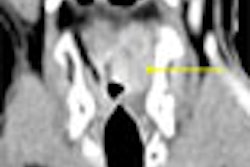Conventional chest CT, as well as CT angiography, imparts a radiation dose that falls between 20-40 mGy, which is not out of the ordinary. But when the patient is a young female, a chest CT exam can deliver 20-50 mGy to the breasts alone. This is the equivalent of 10-25 two-view mammograms or up to 400 chest radiographs, according to investigators in Virginia.
Because a large percentage of patients undergoing pulmonary CT angiography (CTA) are women of reproductive age, radiologists need to pay more attention to the average glandular breast dose, stated Dr. Mark Parker and colleagues from the Medical College of Virginia Hospitals and the Virginia Commonwealth University Health System in Richmond. They conducted a retrospective study looking at effective radiation dose to the female breast during routine pulmonary CTA.
"The number of CT examinations is likely to continue to increase as the clinical threshold for scanning patients continues to decrease," wrote Parker's group from the Medical College of Virginia Hospitals and the Virginia Commonwealth University Health System in Richmond. "Thus, it is imperative to reduce the exposure of breast tissue to ionizing radiation" (American Journal of Roentgenology, November 2005, Vol. 185:5, pp. 1228-1233).
The study was done in four phases: a review of all patients who had pulmonary CTA between May 2000 and December 2002; data collection of the diagnostic outcome of these studies; and classification of studies on an inpatient, outpatient, or emergency department basis. Finally, physicists estimated the effective radiation dose to breast of an average 60-kg female.
In terms of the imaging protocol, 5-mm noncontrast images were acquired using 140 kVp, 120 mAs, and a pitch of 1.5. Then, 2-mm iohexol-enhanced images were obtained using 140 kVp, 120 mAs, and a 2.0 pitch (Plus 4 or Volume Zoom, Siemens Medical Solutions, Malvern, PA).
During the study period, 1,325 pulmonary CTA exams were done and 60% were on female patients with a mean age of 52.5 years. Results were negative for pulmonary thromboembolism in 50.31% of the cases. In women 35 years and younger, 46.1% were negative. The positive yield for pulmonary CTA (64%) was greatest for female inpatients and ER patients.
"The calculated dose to the average 60-kg woman … was 2.0 rad (20 mGy) per breast," the authors stated. "This dose compares with an average glandular breast dose of 0.300 rad (3 mGy) for standard two-view screening mammography. We confirmed that the breast tissue is exposed to a much higher radiation dose … than radiologists, medical physicists, and the American College of Radiology … would desire."
Parker and co-authors offered some suggestions for reducing exposure risk:
- Modify CT scanning protocols (although this can compromise image quality, they acknowledged).
- Use dynamic real-time tube current modulation based on body geometry and attenuation.
- Employ thin-layered bismuth radioprotective garments, which when properly placed, can reduce radiation exposure by 57%.
- Consider ventilation-perfusion scans (V/Q), which can be effective when a patient has a normal chest x-ray and no history of cardiopulmonary disease.
- Use contrast-enhanced 3D MR angiography.
- Try nonimaging tests such as plasma D-dimer enzyme-linked immunosorbent assays. D-dimer tests have a reported negative predictive value of 91%.
By Shalmali Pal
AuntMinnie.com staff writer
November 24, 2005
Related Reading
Flat-panel detectors cut radiation dose in angiography, pediatric chest x-rays, November 4, 2005
Grown-up decisions: When is MDCT the best choice in children? September 30, 2005
Report finds vendors enable excess radiation doses in pediatric CR, DR, February 4, 2005
Ultralow-dose CT lung scan shows high accuracy at chest film dose, December 13, 2004
Copyright © 2005 AuntMinnie.com




















